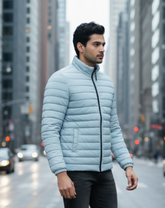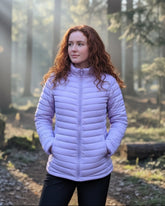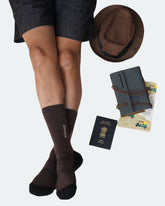22 Things To Know Before Picking A Fabric For Winter

You need a suitable fabric for winter when it's time for the winter season. Thermal Wear for Women Is Warmth, comfort, and safety should be your priorities when you pick a material for winter.Let's try and understand how to handle winter clothes and fabrics throughout the season.
There are some essential fabrics that you must consider when you shop.
How to Handle Winter Clothes
The best winter clothing will keep you safe through the winter season. But you must take good care of every winter fabric you add to your wardrobe.
1. Sort Your Winter Clothes
Before you get ready to store them, you must sort your clothes correctly. Before packing anything away, go through your winter wear. After wearing outfits throughout the season, you might want something new.
There might be chances that you've outgrown your winter clothing. So you should sort out your clothes and see what you need. It's an excellent way to make room for the next season's clothing.
2. Launder and Mend Your Clothing
You must also treat your winter fabrics to a laundry session. You must get this done even if you don't sense stains or odor on them. There could be some unseen spots that become noticeable and permanent over time.
Also, if you see odor on your winter clothing, it can attract pests. So please tackle the issue as soon as possible. You can also send it across for dry cleaning.
You can hand-wash or machine-wash your clothes if it doesn't need dry cleaning. Each fabric for winter would need a different kind of treatment. So you must not treat all winter fabrics the same way.
Examine your sweaters for pills and use a de-pilling tool to correct the issue. It's the best time to mend loose threads, missing buttons, or broken zippers. Along with your clothes, please also look at your footwear.
Your boots need appropriate cleaning and polishing. It must stay intact for the next winter season too.
3. Separate Clothing into Those to Be Folded vs. Hung
When you're sorting out your clothes, you should segregate them. It would help if you separated those that need folding from those that need to be hung. You should fold clothing that could lose shape or stretch out.
It isn't ideal for hanging them in a hangar. And hang clothes that may wrinkle or get damaged if folded. You should ensure that you maintain your classic pieces in good shape.
Place a layer of acid-free tissue paper in the sleeves to do this. You should put it between the folded layers. The tissue paper protects embellishments and prevents any color transfer.

4. Select Containers for Storage
Yes, you should store your clothes when they aren't in use. But have you thought of where you will store them? Plastic storage containers aren't ideal for long-term use.
But they're a good option for seasonal storage. They're a better option compared to cardboard boxes. Cardboard boxes:
- Break down easily
- They are less sturdy than plastic bins and can't be stacked with heavy contents
- They're vulnerable to pests
- Stains might develop if stored for too long.
All the clothes you store must be dry at all times. While plastic containers keep moisture out, they retain trapped moisture. It can produce mold and mildew.
Avoid putting too many clothes into the container. Natural fibers often need space to breathe. Also, if you give them space, you'll see fewer wrinkles.
5. Garment Bags for Items to Be Hanged
When you store clothes made of winter fabrics, choose garment bags. They protect clothes from getting exposed to dust or dirt. They'll also come with zippers attached to them. You need high-quality, breathable garment bags for the best winter fabrics.

6. Avoid Vacuum-Sealed Bags
Vacuum-sealed bags are popular. Clothing won't benefit in a plastic bag with all the air removed. So don't store down jackets, wool, cashmere clothing, and leather items in a vacuum-sealed bag.
As I mentioned, natural fibers need space to breathe. If you remove air from the bag, it could result in compression. In turn, it causes a loss in shape and form.
Some might get back in shape, but some might not. So you should avoid this risk. Vacuum-sealed bags can also have some faults in them.
Since these are plastic bags, they may hold moisture. Lower-quality bags may turn yellow if they're exposed to heat or sunlight. So please don't risk your wardrobe. You could use plastic storage bins instead.
7. Keep Stored Clothes Smelling Fresh
Your clothes smell a little when you get them out of storage. There's one simple method you could use to prevent odor. You can place dryer sheets in the garment bag or storage container. You could also add a sweet-smelling sachet or dried lavender.
If you're concerned about moisture, add some desiccant packs to soak up the humidity. Cedar is another excellent option in this regard. You can place some cedar chips, balls, sachets, or cedar hangers on your winter clothes.
8. Prevent Pests
As mentioned above, pests can be a major concern for your winter clothing. One of the biggest concerns is moths and other bugs. Cleaning your closet after use is one way to prevent pests.
Yes, it's that simple. It's also good to place moth traps or cedar blocks in your closet.
9. Select a Storage Location
Storing your winter clothes is a must. But you should know the ideal location to do it. A naturally cool, dark, and dry place would be great. All stored clothing should ideally be kept away from direct sunlight and heat.
Basics to Maintain The Fabric for Winter Clothes

1. Proper storage is the key to handling winter fabrics with care. During summer, you might see moths and pests if you pack your woolens in suitcases. Hence, before storing them, either hand-wash them or dry-clean them.
It eliminates the chances of any attacks by harmful moths.
2. Store your sweaters and coats in plastic bags. You can store them along with some naphthalene balls. It will prevent a pest attack.
If the sweaters are heavy, fold them instead of hanging them. Use cedar hangers to hang winter wear in your cupboard. It shouldn't have any moisture on it.
3. The fabric for winter clothes should be washed according to the care tag instructions. If it says, "dry-clean only," you shouldn't hand-wash the clothes. Always turn your clothes inside out while washing them.
Don't use harsh detergents to wash winter fabrics. It may cause harm to the fabric's threading.
4. Roll up your winter clothing in heavy towels and keep them for five minutes. Let it squeeze out all the excess water.
5. Once you get rid of the excess water, dry the winter wear in the shade. You can turn them upside down for better cleaning. Don't dry them under direct sunlight. The color of your clothes' winter fabrics might fade away.
6. Woollen coats and jackets will benefit from a gentle wash. You can do it at the beginning and end of each winter season. Since dust and dirt can get stuck to such clothes, it's better to clean them often.
7. You also need to take good care of accessories. One such accessory would be your scarves. If you want your neck to stay warm in winter, take good care of them.
You should hand-wash your scarves at least once a month during winter. If you want to get rid of sweat, dirt, and stains, hand washing is useful. Hand-wash at the beginning and the end of the winter season.
Fashionable Winter Fabrics

Here is some fabric for winter that'll help you look stylish too. Well, there's a wide variety for you to choose from. So take a look at this list first. You might end up liking a few fabrics for winter.
Wool
It's considered to be a staple winter fabric. Wool has found extensive usage over the centuries. Wool is among the best winter fabrics in the market.
It keeps you warm and feels comfortable on the skin too. It'll help you survive during the extremely cold winters as well. It's also a breathable winter fabric.
Hence, it doesn't make one feel too sweaty or hot. Wool is also a quick-dry fabric. So if you come across damp conditions or winter elements, don't stress too much. It will help people stay comfortable and control their body temperature.
Hence, wool is considered among the best winter fabrics for sweaters and cardigans. The list doesn't end there, though. Wool fabric for winter is also easy to maintain.
And yes, the quality also ensures that it's incredibly durable. So woolen clothes won't take much effort to clean and maintain. You'll see it in the following segment.

Cashmere
Cashmere is a luxurious fabric that feels great on the skin. Cashmere is another great fabric for winter. While it's expensive, the quality and knit make it an excellent addition to a winter wardrobe.
It keeps the person warm during the winter season. Hence, cashmere is a winter favorite for sweaters, shawls, and scarves.
Polyester
Synthetic fabrics can also do the trick for you in winter. Polyester is one such synthetic fabric for winter. It's often used for winter wear.
Polyester is durable for winter. It can also be budget-friendly. If you're looking for water-resistant winter fabrics, these can dry quickly, so it would be a good idea to invest in polyester.
Nylon
Here's another synthetic fabric used for winter clothing. It's a durable fabric that you can blend with other fabrics. It requires little upkeep and can be machine-washed in warm water.
Nylon is waterproof and dry. These aspects make it a reliable fabric for winter. Also, nylon isn't expensive, and the manufacturing doesn't cost a lot. It's also lightweight, so, it is easy to carry around.
You'll find nylon on coats, gloves, and thermal underwear.

Leather
Leather is among the fashionable winter fabrics. This fabric for winter is perfectly warm and stylish. You get this fabric in natural and artificial variants. The artificial variant is called faux leather.
Leather is water-resistant and feels cozy in cold weather. You must take good care of it as well. If you do so, it'll last longer.
Leather is used to manufacture jackets, gloves, and boots in winter.
Fleece
Fleece is another reliable fabric for winter. It's one of the most essential and well-known winter fabrics. It's also popular in the fashion world.
It's a warm and fluffy winter fabric. Fleece will keep you warm and add good looks to your wardrobe. It's also pretty comfortable to wear in the cold.
Fleece is considered a cheaper option compared to leather or wool. It's also a water-resistant and breathable fabric. People might also prefer fleece over wool due to its softness and lightweight nature.
Faux Fur
Fur is often the main attraction in winter clothing. This fabric for winter can feel ultra-warm, comfy, and stylish. It's also a sign of luxury.
Like leather, you also get an artificial variant for this fabric. It's known as faux fur. It's an affordable, better alternative to the same.
It keeps you warm and comfortable during chilly winters. You'll often find this fabric on coats and jackets. When they're lined with faux fur, it gives out a bold and statement look.
Due to the look, it also works as a trendy fabric for winter. There's a lot you can wear with faux fur lined on it. So, you must invest in at least one piece made with this fabric for winter.

FAQs
Here are some frequently asked questions about fabrics.
Which fabric is necessary for winter?
Wool, especially Icelandic wool, is warmer than cotton and polyester according to science. The greatest sportswear for keeping warm while exercising in the cold is spandex, closely followed by Gore-tex. The best fabric for keeping you warm is a wool-acrylic combination, followed by cotton-acrylic.
What fabric winter clothes are made of?
A variety of fabrics and materials for winter apparel are manufactured from both natural and synthetic fibers. Wool, linen, silk, leather, hemp, and cotton are among the most popular and natural fibers. Polar fleece, spandex, polyester, nylon, and acrylic are a few examples of synthetic or man-made materials.
What are winter clothes called?
Sweaters, pants, thicker coats and jackets, fleece, scarves, gloves, and hats are some examples of winter clothing. To protect you from harsh temperatures and snow, winter clothing is comprised of heavier, thicker fabrics than summer clothing.
Which coat is warm in winter?
Puffer jackets, as they are commonly called, are made up of feathers that trap air to decrease heat loss and keep you warm in cold weather. Warmth-to-weight ratio and compressibility are key factors in down jacket performance. The North Face down coats are insulated with high-fill goose down, which is perfect for comfort and added warmth.
Why is it better to wear dark clothes in winter?
There is no intermediary need for the radiation-based method of transferring heat. Because dark surfaces absorb more heat than bright surfaces in the winter, we prefer to dress in dark hues. Due to the heat that was absorbed, the object's temperature rises.
Conclusion

Winter fabrics shouldn't be taken lightly. They're worn during the cold season to ensure complete safety. If you neglect this aspect, you could face health concerns.
I hope this guide gave you some options to pick from this winter. Check out some of these winter fabrics in a market.
For any queries related to wearing thermals, base layers, or winter wear in general, visit Kosha’s store and get a free consultation! While you’re at it, check out Kosha’s website for the wide range of thermals and jackets available at Kosha.
This post was written by Kosha team member - Shawn Mathias
Editor’s Picks
Packable Puffer Jacket For Men
- From ₹3,900.00
₹8,400.00- From ₹3,900.00
- Unit price
- / per
Men's Full Sleeves Thermal | Merino Wool + Bamboo
- ₹4,940.00
₹7,600.00- ₹4,940.00
- Unit price
- / per
Alaskan Parka Jacket For Women - Slim Fit
- ₹8,925.00
₹11,900.00- ₹8,925.00
- Unit price
- / per
Lightweight Packable Puffer Jacket For Women
- ₹6,300.00
₹8,400.00- ₹6,300.00
- Unit price
- / per
Men's Merino Wool Cushioned Technical Socks
- ₹1,074.00
₹1,790.00- ₹1,074.00
- Unit price
- / per













